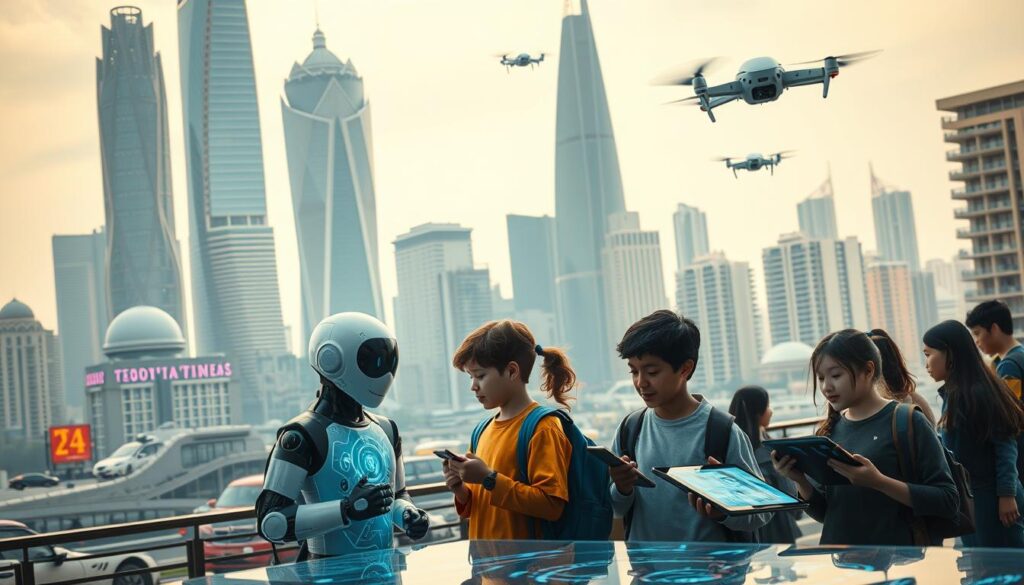“The future belongs to those who believe in the beauty of their dreams,” said Eleanor Roosevelt. Today, that future is being shaped by a remarkable innovation in artificial intelligence, capturing global attention. Imagine a young boy in Beijing, Timmy, playing chess with a robot that learns and adapts in real-time. This is not science fiction—it’s reality.
China is emerging as a leader in the AI revolution, with state-backed investments fueling rapid growth. Over 4,500 firms are developing cutting-edge technologies, and the country plans to invest 10 trillion yuan in AI over the next 15 years1. This commitment is setting new standards in the industry, reshaping markets and attracting investors worldwide.
From chess-playing robots to advanced models like Manus, which can control 50 screens simultaneously, the results are astounding2. These innovations are not just transforming industries but also changing how people interact with technology. The release of such breakthroughs is a testament to China’s vision of becoming a global AI leader.
As the world watches, the implications of this progress are profound. Stay tuned as we explore the details of this groundbreaking journey and its impact on the future of technology.
Key Takeaways
- China is investing heavily in artificial intelligence, with plans to spend 10 trillion yuan over 15 years1.
- Over 4,500 companies are driving innovation in AI technologies.
- Advanced models like Manus are setting new benchmarks in automation2.
- State-backed funding is accelerating China’s rise as a global AI leader.
- These breakthroughs are reshaping markets and attracting global investors.
Introduction to China’s AI Revolution

Over the past decade, artificial intelligence has become a cornerstone of technological progress globally. China’s rapid rise in this field is reshaping industries and economies. With state-backed investments, the country is positioning itself as a leader in AI innovation3.
Overview of the Groundbreaking Innovation
Artificial intelligence refers to systems that mimic human intelligence to perform tasks. Innovations like DeepSeek are pushing boundaries, offering solutions that were once unimaginable. For instance, DeepSeek’s R1 model was trained at a cost of $6 million, significantly lower than traditional models3.
Chip technology plays a critical role in AI development. Advances in this area have reduced costs and improved efficiency. This has made AI more accessible to companies and individuals alike.
Context in the Global Tech Landscape
China’s strategic investments in AI are challenging Western dominance. The country’s focus on research and development is driving innovation at an unprecedented pace. Experts predict that this will lead to significant shifts in the global market4.
Policy changes and technological restrictions are also accelerating progress. For example, U.S. export restrictions have pushed China to develop its own solutions. This has created a competitive environment that benefits the entire industry.
For more insights into how AI is transforming the tech landscape, check out this detailed analysis.
Government Investments and Policy Initiatives

Government-backed initiatives are driving unprecedented advancements in technology. With a focus on artificial intelligence, China is investing heavily to secure its position as a global leader. Strategic roadmaps and multi-trillion-yuan funding are accelerating development in this critical sector5.
State Funding and Strategic Roadmaps
State funding plays a pivotal role in fostering innovation. China’s 10 trillion yuan investment plan is designed to support research and development over the next 15 years6. This commitment is not just about financial resources but also about creating a sustainable ecosystem for technological growth.
Strategic roadmaps outline key areas of focus, including chip technology and automation. These plans aim to address challenges like chip shortages and export restrictions. By prioritizing domestic solutions, the government is reducing reliance on foreign technologies5.
Impact of U.S. Export Restrictions and Sanctions
U.S. export restrictions have had a significant impact on the global tech landscape. For China, these sanctions have fueled domestic innovation. Engineers and companies are now developing homegrown solutions to overcome barriers5.
For example, DeepSeek’s AI model was trained using fewer chips and at a lower cost compared to Western models6. This demonstrates how restrictions have spurred creativity and efficiency in the industry.
The broader market implications are also noteworthy. Stock performance and investor sentiment have shifted in response to these developments. Companies leveraging state support are gaining traction, attracting both domestic and international investors6.
| Key Initiative | Impact |
|---|---|
| 10 Trillion Yuan Investment | Accelerates AI research and development6 |
| Domestic Chip Production | Reduces reliance on foreign technologies5 |
| Response to U.S. Sanctions | Fuels innovation and competitive responses5 |
Chinese companies are also leveraging soft power through social media engagement. Public access to advancements in artificial intelligence is fostering a sense of national pride and global influence5. For more insights into how these developments are shaping the tech landscape, explore this detailed analysis.
Silicon Valley Reaction and Global Market Impact

Silicon Valley’s tech giants are grappling with the rapid rise of China’s advancements in artificial intelligence. The announcement of DeepSeek’s capabilities, developed at a fraction of the cost compared to Western models, has sent shockwaves through the industry7. NVIDIA’s stock dropped by 15%, resulting in significant market value losses8.
Investors are closely monitoring the situation, with the tech-heavy Nasdaq falling by 3.5% in response7. This volatility highlights the growing influence of China’s innovations on global markets. Experts suggest that these developments could reshape the competitive landscape in the coming years.
Stock Market Volatility and Investor Concerns
The sharp decline in NVIDIA’s stock reflects broader investor concerns. Analysts attribute this to the competitive edge gained by Chinese firms like DeepSeek, which developed a large language model in just two months at a cost of under $6 million8. Such efficiency is challenging traditional players in the industry.
Weekly trends show heightened sensitivity to announcements from China. The timing of these breakthroughs has added pressure on U.S. companies to innovate faster. Regulatory restrictions have further complicated the situation, creating a volatile environment for investors7.
The Role of Media in Shaping Public Perception
Media narratives are playing a crucial role in shaping public opinion. Influential figures like Donald Trump have called China’s advancements a wake-up call for U.S. tech dominance8. This rhetoric has amplified concerns among stakeholders and the general public.
Real-time market data and expert analysis are guiding investor decisions. For instance, the Pentagon’s Joint Artificial Intelligence Center has expanded its focus to address these challenges8. Such developments underscore the intersection of technology and investor confidence.
| Key Event | Impact |
|---|---|
| NVIDIA Stock Drop | 15% decline, market value loss8 |
| Nasdaq Fall | 3.5% drop following DeepSeek’s announcement7 |
| Donald Trump’s Comments | Highlighted U.S. tech challenges8 |
For more insights into how these developments are shaping the tech landscape, explore this detailed analysis.
This AI Breakthrough in China Will Blow Your Mind!

The global tech landscape is witnessing a seismic shift, driven by groundbreaking advancements in artificial intelligence. DeepSeek’s disruptive model has redefined expectations, achieving benchmarks comparable to leading Western technologies at a fraction of the cost9.
Training costs for DeepSeek’s R1 model were under $6 million, significantly lower than OpenAI’s tens of millions9. This efficiency has challenged traditional paradigms, forcing competitors to rethink their strategies. The release of DeepSeek-V3 as the most-downloaded free app on Apple devices further underscores its global appeal9.
Investor reactions have been dramatic. NVIDIA’s stock plummeted by 17%, marking the largest single-day loss in U.S. corporate history10. The Nasdaq 100 index also lost $1 trillion in value, reflecting the market’s sensitivity to these developments9.
Emerging trends highlight the rapid rise of AI-driven apps and digital market transformations. DeepSeek’s success has intensified the technological “war,” with global trade dynamics shifting in response7. This competition is reshaping industry standards and redefining leadership in the tech sector.
The transformative results are already visible. DeepSeek’s innovative approach has set a new benchmark for cost efficiency and performance. This breakthrough is not just a milestone but a catalyst for future advancements.
| Key Development | Impact |
|---|---|
| DeepSeek’s Training Cost | Under $6 million, challenging competitors9 |
| NVIDIA Stock Drop | 17% decline, largest single-day loss10 |
| DeepSeek-V3 App Release | Most-downloaded free app on Apple devices9 |
For more insights into how these advancements are shaping the tech landscape, explore this detailed analysis.
Innovative Applications: From Robotics to Education

Everyday life is being reshaped by the integration of advanced technologies into consumer products and educational systems. From smart devices to classroom tools, these innovations are making technology more accessible and impactful. For instance, the coffee table robot is a prime example of how robotics is blending seamlessly into domestic spaces.
Powerful models like DeepSeek V3, with 671 billion parameters, are driving cost efficiencies, enabling broader applications in consumer tech11. These advancements are not just about hardware but also about creating smarter, more intuitive products. Weekly updates and iterative improvements ensure that these devices remain cutting-edge, meeting consumer demands effectively.
AI Integration in Consumer Products and Smart Devices
Smart devices are becoming more intelligent, thanks to advancements in chip technology and machine learning. Companies are leveraging these innovations to develop products that enhance daily routines. For example, smart home systems now use AI to optimize energy consumption and improve security.
Collaborative efforts among industry teams are overcoming technological restrictions, delivering smarter solutions to the market12. Firms like DeepSeek are setting benchmarks with their efficient models, which are transforming the way people interact with technology. These developments are not just limited to gadgets but extend to services that simplify tasks and save time.
Enhancing STEM Education and Early Learning
Educational systems are also benefiting from these advancements. Initiatives like AI courses in Beijing schools are preparing young learners for a tech-driven future11. These programs focus on STEM education, equipping students with the skills needed to thrive in an increasingly digital world.
Innovative tools are making learning more engaging and personalized. For instance, AI-powered platforms can adapt to a student’s learning pace, ensuring better outcomes. This approach is transforming educational methods, making them more effective and inclusive.
For more insights into how these technologies are shaping education, explore this detailed analysis.
Economic Disruption and Trade Dynamics
Global markets are experiencing significant shifts due to recent technological advancements. These changes are reshaping trade dynamics and influencing investor behavior. Many companies are recalibrating their strategies to adapt to the evolving landscape13.
Investor Reactions and Industry Shifts
Stock valuations are fluctuating as new models are reducing production costs and increasing efficiency. At the same time, investor sentiment is shifting towards firms that leverage these innovations. Monthly trends show significant adjustments in market forecasts14.
Engineers are driving innovation, particularly in chip technology, which is crucial for reducing costs. These developments are influencing international trade dynamics, with many firms adapting to stay competitive. The tech industry is witnessing changes that are reshaping global markets13.
Trade Wars and the Future of Technology Exports
Trade wars are impacting exports, with pricing strategies being reevaluated. Government policies are playing a key role in shaping these dynamics. Attention is shifting towards new technologies that could redefine the way trade is conducted14.
At this moment, the industry is evolving rapidly, with collateral effects on related sectors. The place of China in global trade is changing, and many people are paying attention to these shifts. Each person is affected differently, depending on their role in the market13.
| Key Factor | Impact |
|---|---|
| Stock Valuations | Fluctuating due to new models and cost reductions14 |
| Trade Wars | Influencing exports and pricing strategies13 |
| Government Policies | Shaping trade dynamics and market behavior14 |
For more insights into how these developments are shaping the tech landscape, explore this detailed analysis.
Data Security, Privacy Concerns, and Regulatory Challenges
Data security and privacy concerns are at the forefront of global discussions surrounding advanced technologies. As models like DeepSeek gain traction, questions about cybersecurity vulnerabilities and regulatory oversight have intensified. Over the past year, governments and firms have grappled with balancing innovation and the need to protect sensitive information15.
Cybersecurity and Vulnerabilities in AI Models
New models, while efficient, often come with significant cybersecurity risks. DeepSeek’s privacy policy, for instance, collects personal data such as email addresses, phone numbers, and chat history15. This has raised concerns about unauthorized access and potential misuse. Chip technology plays a critical role in addressing these vulnerabilities, but challenges remain.
Weekly developments highlight the evolving nature of these threats. Teams are working to resolve issues, but the rapid pace of innovation often outpaces security measures. Liang Wenfeng, a prominent industry figure, emphasized the need for stronger collaboration between tech teams and regulators to address these problems effectively16.
Government Oversight and International Regulations
International regulatory responses have been swift. South Korea, Taiwan, and Australia have implemented temporary bans on DeepSeek for government employees, citing security risks15. These actions reflect growing concerns about data handling practices and the potential for unauthorized access.
At this moment, the industry is adapting to these restrictions. Firms are reevaluating their strategies to ensure compliance while continuing to innovate. The place of China in global trade is changing, and many people are paying attention to these shifts. Each person is affected differently, depending on their role in the market16.
| Country | Regulatory Action | Date |
|---|---|---|
| South Korea | Temporary ban on DeepSeek for government employees | January 31, 202315 |
| Taiwan | Blocked DeepSeek for public sector departments | February 1, 202316 |
| Australia | Complete block on DeepSeek across government devices | February 6, 202315 |
For more insights into how these developments are shaping the tech landscape, explore this detailed analysis.
Conclusion
Recent advancements in technology have reshaped the global market, with Chinese firms gaining a competitive edge. DeepSeek’s model, developed at a fraction of the cost, has challenged traditional players and redefined expectations17. This breakthrough has not only influenced investor sentiment but also sparked discussions on the future of trade dynamics.
Government policies and social media have played pivotal roles in shaping public perception. Figures like Donald Trump and experts such as Liang Wenfeng have highlighted the implications of these developments18. The result is a rapidly evolving industry, where access to advanced technologies is becoming a key differentiator.
Looking ahead, the way these innovations are adopted will determine their long-term impact. Will they redefine global leadership in technology? Explore more on how these advancements are transforming the world in this detailed analysis.
FAQ
What makes China’s AI innovation stand out globally?
How do U.S. export restrictions affect China’s tech industry?
What role does media play in shaping perceptions of China’s AI advancements?
How is AI being integrated into consumer products in China?
What are the cybersecurity concerns surrounding AI development?
How is China’s AI breakthrough impacting global trade dynamics?
What are the implications of China’s AI advancements for education?
Source Links
- From chatbots to intelligent toys: How AI is booming in China
- Manus AI: China’s new AI agent can plan your Japan trip and offer analysis of stocks. 10-point explainer
- China’s AI Breakthrough Rewrites the Script
- China has a new ‘completely autonomous’ AI agent. Here’s what to know about Manus
- DeepSeek: How China’s ‘AI heroes’ overcame US curbs to stun Silicon Valley
- China’s AI Breakthrough Sends NVIDIA Reeling and Sparks National Security Fears
- Why DeepSeek’s Surprise Breakthrough Shouldn’t Have Come as a Surprise
- The Alarming National Security Implications of DeepSeek and China’s A.I. Breakthrough
- Why Everyone Is Freaking Out About DeepSeek, China’s Answer to ChatGPT
- DeepSeek and Qwen2.5-Max: China’s Bold Move to Lead the AI Race | Vilmate
- [AI News] AI in 2025: What’s Next? DeepSeek V3, 2024 Trends, and the Future of Medicine and Education
- The Future of Humanity in 10 Years: 20 Visionary Predictions for 2035 That Will Blow Your Mind
- U.S.-China Relations for the 2030s: Toward a Realistic Scenario for Coexistence
- Targeting China, Biden fires a big tech salvo at the entire world
- Use DeepSeek with caution: What has triggered global concerns about the Chinese rival to ChatGPT?
- DeepSeek: The Chinese AI start-up worrying governments around the world
- How DeepSeek has blown open AI race between US and China
- DeepSeek, Huawei, Export Controls, and the Future of the U.S.-China AI Race







